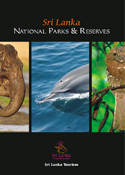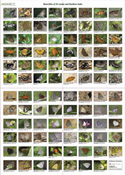Publications

de Silva Wijeyeratne, G. (2008). Sri Lanka National Parks and Reserves. 2nd Edition. Sri Lanka Tourism: Colombo. 56 pages. Hardback. ISBN 955-107914-0. A fifty six page overview of the key sites for eco-tourism in Sri Lanka with brief details on logistics. Lavishly illustrated with colour photographs and laid out in a coffee table book style to be used as a marketing tool as well as an introduction to Sri Lanka’s wilderness areas

de Silva Wijeyeratne, G. (2007). The Endemic Birds of Sri Lanka. Jetwing Eco Holidays, Colombo. 44 pages. A5. Self cover. ISBN 978-955-1079-13-0.
A photographic guide to the endemic birds of Sri Lanka with descriptions and illustrations of each species.

de Silva Wijeyeratne, G. (2010). A Pictorial Guide and Checklist of the Birds of Sri Lanka. Sri Lanka Tourism Promotion Bureau, Colombo. e Edition. 66 pages. A4.A lavishly produced checklist with photographic plates facing the checklist pages. Photographs of 281 species. The checklists contain a map of key birding sites in Sri Lanka, a booklist, a discussion on the uses of a checklist and the nomenclature, taxonomy and the status of birds as used in the checklist. Twenty one columns of tick boxes.

de Silva Wijeyeratne, G. (2006, several reprints). Butterflies of Sri Lanka and Southern India. Gehan’s Photo Booklet Series. 26 plates (A5). Jetwing Eco Holidays: Colombo. ISBN 955-1079-11-6.A booklet comprising of 26, A5 sized, colour plates with captioned photographs. Covers 96 of Sri Lanka’s 243 described species of butterflies and skippers (Lepidoptera). A pdf of the booklet can be downloaded (free of charge)

de Silva Wijeyeratne, G. (2010). Butterflies of Sri Lanka. Gehan’s Photo Booklet Series. 26 plates (A5). Sri Lanka Tourism Promotion Bureau, Colombo. e Edition. A booklet comprising of 26, A5 sized, colour plates with captioned photographs. Covers 96 of Sri Lanka’s 243 described species of butterflies and skippers (Lepidoptera).

de Silva Wijeyeratne, G. (2007). Butterflies of Sri Lanka and Southern India. Gehan’s Poster Series. Jetwing Eco Holidays, Colombo. A1.
A photographic poster illustrating 132 of the commoner species of butterflies of Sri Lanka and Southern India. A lavish poster folding out from A4 format into a size of 8 sheets of A4 (A1). Ideal for a classroom or a child’s bedroom.

de Silva Wijeyeratne, G. (2006). Birds of Sri Lanka and Southern India. Gehan’s Photo Booklet Series. 42 plates (A5). Jetwing Eco Holidays: Colombo. ISBN 955-1079-10-8. A booklet comprising of 42, A5 sized, colour plates with captioned photographs. Covers 263 of Sri Lanka’s 444 recorded species of resident and migratory birds. Eco Holidays: Colombo. A pdf of the booklet can be downloaded (free of charge) from stag2.mydemoview.com/jetwingeco.“An excellent first step for anyone, old or young, into the magic world of the birds of Sri Lanka”.
John Harrison, author of a Field Guide to the Birds of Sri Lanka, Oxford University Press.
de Silva Wijeyeratne, G. (2010). Birds of Sri Lanka. Gehan’s Photo Booklet Series. 42 plates (A5). Sri Lanka Tourism Promotion Bureau, Colombo. e Edition. A booklet comprising of 42, A5 sized, colour plates with captioned photographs. Covers 263 of Sri Lanka’s 444 recorded species of resident and migratory birds. Eco Holidays: Colombo.

de Silva Wijeyeratne, G. (2006, several reprints). Butterflies of Sri Lanka and Southern India. Gehan’s Photo Booklet Series. 26 plates (A5). Jetwing Eco Holidays: Colombo. ISBN 955-1079-11-6.A booklet comprising of 26, A5 sized, colour plates with captioned photographs. Covers 96 of Sri Lanka’s 243 described species of butterflies and skippers (Lepidoptera). A pdf of the booklet can be downloaded (free of charge) from stag2.mydemoview.com/jetwingeco

De Silva Wijeyeratne, G. (2011). Sri Lanka: The Best for Big Game Outside Africa. Sri Lanka Tourism Promotion Bureau, Colombo. e Edition. 16 pages. A4.
Explains why the small island of Sri Lanka is the best for Big Game Safaris outside Africa. The article discusses a framework for choosing charismatic animals as a target species for big game safaris and examines what is available in the different continents and why in the final analysis it is a choice between India and Sri Lanka.









